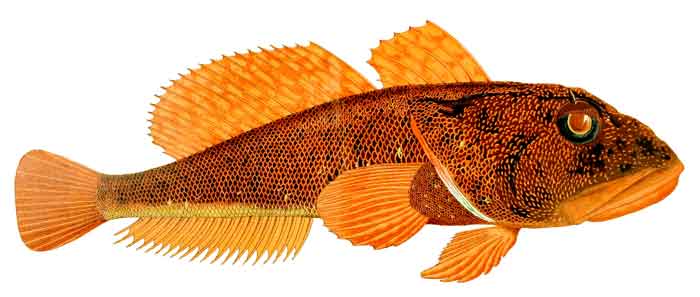Superregnum: Eukaryota
Cladus: Unikonta
Cladus: Opisthokonta
Cladus: Holozoa
Regnum: Animalia
Subregnum: Eumetazoa
Cladus: Bilateria
Cladus: Nephrozoa
Superphylum: Deuterostomia
Phylum: Chordata
Subphylum: Vertebrata
Infraphylum: Gnathostomata
Megaclassis: Osteichthyes
Superclassis/Classis: Actinopterygii
Classis/Subclassis: Actinopteri
Subclassis/Infraclassis: Neopterygii
Infraclassis: Teleostei
Megacohors: Osteoglossocephalai
Supercohors: Clupeocephala
Cohors: Euteleosteomorpha
Subcohors: Neoteleostei
Infracohors: Eurypterygia
Sectio: Ctenosquamata
Subsectio: Acanthomorphata
Divisio/Superordo: Acanthopterygii
Subdivisio: Percomorphaceae
Series: Eupercaria
Ordo: Perciformes
Subordo: Notothenioidei
Familia: Bovichtidae
Genus: Cottoperca

Cottoperca gobio
Cottoperca is a genus of marine ray-finned fishes belonging to the family Bovichtidae, the temperate icefishes or thornfishes. They are found in the southeastern Pacific, southwestern Atlantic and northern Southern Oceans off southern South America.
Taxonomy
Cottoperca was first formally described as a genus in 1875 by the Austrian ichthyologist Franz Steindachner with Cottoperca rosenbergii which Steindachner described as its only species.[1] C. rosenbergii was later found to be a synonym of Batrachus trigloides which had been described by the German naturalist Johann Reinhold Forster in 1801.[2] Some taxonomic authorities consider that Cottoperca is monotypic and that the only valid species is C. gobio,[3] while others state the only valid species is C. trigloides,[4] although this is not the position taken by the 5th edition of Fishes of the World,[5] World Register of Marine Species,[6] FishBase[7] or the Catalog of Fishes, which all give the genus 2 species.[2] The genus name is made up from cottus, meaning "sculpin" and perca which means "perch", an allusion Steindachner did not explain but which is probably a reference to the sculpin like shape of C. rosenbergii.[8]
Species
There are currently two recognized species in this genus:[7]
Cottoperca gobio (Günther, 1861) (Channel bull blenny)
Cottoperca trigloides (J. R. Forster, 1801) (Frogmouth)
Characteristics
Cottoperca species are larger than the related Bovichtus species, with a maximum total length of 80 cm (31 in), and unlike them they are clothed in scales. The large head is bony with only weak spines on the operculum. There is a small fleshy tentacle above each eye. Like Bovichtus they have robust lower fin rays on the pelvic fin as an adaptation for gripping onto the substrate.[9]
Distribution and habitat
Cottoperca fishes are found in the waters off the southern cone of South America in the southwestern Atlantic around Cape Horn and Tierra de Fuego into the southeastern Pacific Ocean. Their range extends as far north as 41°S and south to 54°S.[10] They can be found in shallow waters as well as in water that is hundreds of metres deep, although they are typically found at depths of 100 to 150 m (330 to 490 ft).[9]
Biology
Cottoperca fishes are benthic ambush predators, feeding mostly on fish, small crustaceans and some algae. They have a high reproductive capacity and rates of growth which have enabled them to live on a large area of the Patagonian Shelf Studies performed in the Beagle Channel indicated that C. trigloides lives around the holdfasts in kelp forests dominated by Macrocystis pyrifera.[10] Although most of the prey of these fishes is benthic they are known to eat large amounts of the nectonic herring Sprattus fuegensis.[9] They lay egg masses which stick to the substrated. They are known to live for at least 8 years.[4]
Fisheries and conservation
Cottoperca are not utilized, but they commonly discarded as bycatch in hake and shrimp fisheries. This bycatch is not thought to threaten the population of C. trigloides which is classed as Least Concern by the IUCN.[4]
References
Eschmeyer, William N.; Fricke, Ron & van der Laan, Richard (eds.). "Genera in the family Bovichtidae". Catalog of Fishes. California Academy of Sciences. Retrieved 13 September 2021.
Eschmeyer, William N.; Fricke, Ron & van der Laan, Richard (eds.). "Species in the genus Cottoperca". Catalog of Fishes. California Academy of Sciences. Retrieved 13 September 2021.
"Cottoperca Steindachner, 1876". ITIS. Retrieved 13 September 2021.
Buratti, C.; Díaz de Astarloa, J.; Hüne, M.; et al. (2020). "Cottoperca trigloides". IUCN Red List of Threatened Species. 2020: e.T195047A2373791. doi:10.2305/IUCN.UK.2020-3.RLTS.T195047A2373791.en. Retrieved 13 September 2021.
J. S. Nelson; T. C. Grande; M. V. H. Wilson (2016). Fishes of the World (5th ed.). Wiley. p. 464. ISBN 978-1-118-34233-6. Archived from the original on 2019-04-08. Retrieved 2021-09-13.
Nicolas Bailly (2014). "Cottoperca". WoRMS. World Register of Marine Species. Retrieved 13 September 2021.
Froese, Rainer and Pauly, Daniel, eds. (2021). Species of Cottoperca in FishBase. June 2021 version.
Christopher Scharpf & Kenneth J. Lazara, eds. (12 April 2021). "Order Perciformes: Suborder Notothenoididei: Families Bovichtidae, Pseaudaphritidae, Elegopinidae, Nototheniidae, Harpagiferidae, Artedidraconidae, Bathydraconidae, Channichthyidae and Percophidae". The ETYFish Project Fish Name Etymology Database. Christopher Scharpf and Kenneth J. Lazara. Retrieved 13 September 2021.
Joseph T. Eastman (1993). Antarctic Fish Biology: Evolution in a Unique Environment. Academic Press. pp. 69–70. ISBN 978-0-12-228140-2.
María Eugenia Lattuca; Facundo Llompart; Esteban Avigliano; et al. (2020). "First Insights Into the Growth and Population Structure of Cottoperca trigloides (Perciformes, Bovichtidae) From the Southwestern Atlantic Ocean". Frontiers in Marine Science. 7: 421. doi:10.3389/fmars.2020.00421. hdl:11336/128440.
Retrieved from "http://en.wikipedia.org/"
All text is available under the terms of the GNU Free Documentation License

